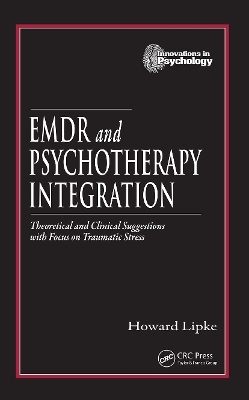
EMDR and Psychotherapy Integration
Theoretical and Clinical Suggestions with Focus on Traumatic Stress
Seiten
1999
Crc Press Inc (Verlag)
978-0-8493-0630-3 (ISBN)
Crc Press Inc (Verlag)
978-0-8493-0630-3 (ISBN)
Initially regarded as one of the most peculiar methods of psychotherapy ever devised, EMDR was introduced to psychotherapists when Dr Francine Shapiro reported demonstrable rapidly effective treatment results. This title can help satisfy the need for a scholarly work on this demonstrably effective method of psychotherapy.
Initially regarded as one of the most peculiar methods of psychotherapy ever devised, EMDR (eye movement desensitization and reprocessing) was introduced to psychotherapists 11 years ago when Dr. Francine Shapiro reported demonstrable rapidly effective treatment results. An early endorsement by the late Dr. Joseph Wolpe, a founder of behavior therapy, and confirmatory research studies have led to wide and rapid acceptance by practitioners.
Dr. Howard Lipke, the first clinician authorized by Dr. Shapiro to independently offer EMDR training, has written a book which elaborates on Shapiro's Accelerated Information Processing model in offering what Lipke calls the Four Activity Model (FAM) of Psychotherapy. This model advances the integration of EMDR theory and practice with dynamic, behavioral and humanistic methods, as well as with previous prominent integrative models.
Recognizing the commonalities in human healing/growth traditions, the text also offers therapeutic suggestions for use of EMDR that rely on the wisdom of previously established psychotherapies as well as that of religion and philosophy. While there is an emphasis on combat-related psychological problems, Dr. Lipke demonstrates how combat trauma and treatment contain the elements of a broad range of potentially traumatic events and the treatment of destructive stress reactions.
Indeed, Dr. Lipke's EMDR and Psychotherapy Integration has helped satisfy the need for a scholarly work on this demonstrably effective method of psychotherapy.
Initially regarded as one of the most peculiar methods of psychotherapy ever devised, EMDR (eye movement desensitization and reprocessing) was introduced to psychotherapists 11 years ago when Dr. Francine Shapiro reported demonstrable rapidly effective treatment results. An early endorsement by the late Dr. Joseph Wolpe, a founder of behavior therapy, and confirmatory research studies have led to wide and rapid acceptance by practitioners.
Dr. Howard Lipke, the first clinician authorized by Dr. Shapiro to independently offer EMDR training, has written a book which elaborates on Shapiro's Accelerated Information Processing model in offering what Lipke calls the Four Activity Model (FAM) of Psychotherapy. This model advances the integration of EMDR theory and practice with dynamic, behavioral and humanistic methods, as well as with previous prominent integrative models.
Recognizing the commonalities in human healing/growth traditions, the text also offers therapeutic suggestions for use of EMDR that rely on the wisdom of previously established psychotherapies as well as that of religion and philosophy. While there is an emphasis on combat-related psychological problems, Dr. Lipke demonstrates how combat trauma and treatment contain the elements of a broad range of potentially traumatic events and the treatment of destructive stress reactions.
Indeed, Dr. Lipke's EMDR and Psychotherapy Integration has helped satisfy the need for a scholarly work on this demonstrably effective method of psychotherapy.
Howard Lipke
The Scientific Evidence and EMDR. Accelerated Information Processing. EMDR and The Four-Activity Model of Psychotherapy. Clinical Recommendations Prior to category 3 Activity. Category 3 Activity and Its Vicissitudes. End of Session, End of Treatment. Appendix 1: Feelings Identification and Behavior Rehearsal (FIBRe Group). Appendix 2: Substance Abuse. References. Index.
| Erscheint lt. Verlag | 24.11.1999 |
|---|---|
| Reihe/Serie | Innovations in Psychology Series |
| Verlagsort | Bosa Roca |
| Sprache | englisch |
| Maße | 152 x 229 mm |
| Gewicht | 490 g |
| Einbandart | gebunden |
| Themenwelt | Geisteswissenschaften ► Psychologie ► Test in der Psychologie |
| Medizin / Pharmazie ► Allgemeines / Lexika | |
| Medizin / Pharmazie ► Medizinische Fachgebiete ► Neurologie | |
| Medizin / Pharmazie ► Medizinische Fachgebiete ► Notfallmedizin | |
| Medizin / Pharmazie ► Medizinische Fachgebiete ► Psychiatrie / Psychotherapie | |
| ISBN-10 | 0-8493-0630-2 / 0849306302 |
| ISBN-13 | 978-0-8493-0630-3 / 9780849306303 |
| Zustand | Neuware |
| Haben Sie eine Frage zum Produkt? |
Mehr entdecken
aus dem Bereich
aus dem Bereich
Buch | Softcover (2023)
Springer (Verlag)
CHF 62,95
warum es gut ist, das Leben zu hinterfragen
Buch | Hardcover (2024)
Ullstein Buchverlage
CHF 34,95


